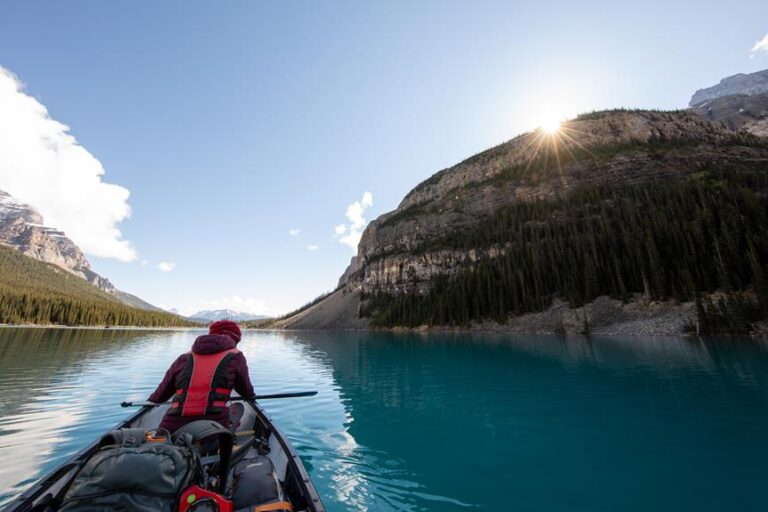Are you ready to embark on an exciting kayak camping adventure? Before you hit the water, it's crucial to know how to pack your kayak properly. We'll guide you through the process, ensuring you have all the gear for a successful trip.
From choosing the right destination to mastering packing techniques, we've got you covered. Whether you're a beginner or a seasoned paddler, this guide will help you optimize space, stay organized, and ensure your safety.
Get ready to explore, sleep under the stars, and immerse yourself in the freedom of nature. Let's dive into the world of kayak camping!
Key Takeaways
- Start with a single overnight trip to learn how to pack your boat economically and develop a system for easy access.
- Refine your gear list and packing techniques with each trip to make it easier.
- Remove air from dry-sacks before packing them to save space.
- Mold bulky yet malleable items like sleeping bags to fit into narrower ends of the boat.
Essential Gear for Kayak Camping
First, you'll need to gather the essential gear for your kayak camping trip. As an experienced kayaker, you understand the importance of having the right equipment for a successful adventure.
Start with the basics: a reliable kayak, a paddle (don't forget a spare!), and a PFD with a whistle attached for safety. You'll also need a sprayskirt to keep water out of your cockpit and a paddle float in case of capsize. Don't forget essentials like a throw bag, pump or bailing device, sponge, and dry bags for your gear.
For camping, pack a tent, sleeping bag, sleeping pad, camp pillow, and a foldable chair for comfort. A portable stove, gas canister, lighter, pot, and plate are necessary for cooking. Remember to bring a cell phone, emergency beacon, waterproof camera, and headlamp with spare batteries. Don't forget personal items like a toothbrush, toothpaste, sunscreen, wet wipes, toilet paper, and lip balm.
For meals, pack dehydrated options and use ziplock bags for food storage. Consider a Jetboil flash for cooking and bulk packaging removal to save space. Lastly, bring water storage containers for hydration.
When it comes to clothing, prioritize quick-dry materials like polyester or merino wool. Pack a long sleeve quick-dry top, quick-dry leggings, drytop or full drysuit, neoprene boots or sandals, waterproof hat or ball cap, something to sleep in, fleece or comfortable pants, a down or synthetic jacket, beanie, gloves, and camp shoes.
Remember, the key to packing your kayak efficiently is to start with a single overnight trip to learn how to pack economically. Refine your gear list and packing techniques with each trip to make it easier. Remove air from dry-sacks before packing to save space and mold bulky yet malleable items like sleeping bags to fit into narrower ends of the boat. Fill bulky items like pots with socks or clothing to maximize space.
As for choosing a kayak camping destination, consider your experience level. Beginners should explore protected areas like lakes or inlets before venturing into the open ocean. Vancouver Island in BC, Canada offers a variety of destinations suitable for both beginners and seasoned paddlers. Desolation Sound, the Broughton Archipelago, the Broken Group Islands, and Nuchatlitz Provincial Park are all great options.
When it comes to navigation and safety, always use a detailed, water-resistant chart and GPS as a backup. Consider using a smartwatch with navigation capabilities for a hands-free experience. Charts like Wild Coast Publishing provide valuable information on hazards, launch areas, campsites, and trip planning. Download navigation apps or maps on your smartphone for offline use, but always carry a detailed chart in case of technology failure. Stay updated on tides, currents, and swells using apps like AyeTides.
Lastly, kayak camping offers a unique wilderness experience that combines the freedom of kayaking with the tranquility of camping. So get out there and enjoy the beauty of nature from your kayak.
Efficient Packing Techniques for a Kayak
To maximize space and ensure you have everything you need, pack your kayak efficiently using these simple techniques.
First, remove air from dry-sacks before packing them to save space. Squeeze out the air and seal the bags tightly.
Next, mold bulky yet malleable items like sleeping bags to fit into narrower ends of the boat. This will help utilize the available space effectively.
Additionally, fill bulky items like pots with socks or clothing to maximize space. Stuffing these items with soft materials will prevent them from taking up unnecessary room.
Lastly, consider using bulk packaging removal for space-saving. Take your dehydrated meals out of their original packaging and transfer them into ziplock bags. This will save space and make it easier to organize your food.
Choosing the Right Destination for Kayak Camping
When planning your kayak camping adventure, consider both your experience level and the destination you choose.
For beginners, it's best to start in protected areas like lakes or inlets before venturing into the open ocean. Vancouver Island in BC, Canada offers a range of options for both beginners and seasoned paddlers. Desolation Sound and the Broughton Archipelago on the East Coast are perfect for beginner to intermediate paddlers, while the Broken Group Islands and Nuchatlitz Provincial Park on the West Coast are ideal for intermediate to expert sea kayakers.
These destinations provide stunning scenery, abundant wildlife, and opportunities for exploration. Choosing the right destination will ensure a safe and enjoyable kayak camping experience.
As you plan your trip, it's important to also consider navigation and safety tips for kayak camping.
Navigation and Safety Tips for Kayak Camping
Use a detailed chart and GPS as your backup for navigation during your kayak camping trips. These tools will ensure that you stay on course and reach your desired destinations safely. Consider using a smartwatch with navigation capabilities for a hands-free experience.
Charts like Wild Coast Publishing provide valuable information on hazards, launch areas, campsites, and trip planning. Download navigation apps or maps on your smartphone for offline use. Always carry a detailed chart in case of technology failure.
Tides are important to consider for launching, landing, currents, and swells. Use apps like AyeTides to check tide information for any date in the future. AyeTides displays high, low, and slack tides, as well as current directions and speeds.
Stay updated on sun and moonrise times for better planning. Safety is paramount when kayak camping, so make sure you're well-prepared and informed before embarking on your adventure.
Benefits and Final Thoughts on Kayak Camping
For an unforgettable outdoor experience, consider the freedom and tranquility of exploring nature from your kayak, as well as the convenience and simplicity of camping along the way.
Kayak camping offers a unique wilderness experience that allows you to paddle to remote beaches away from civilization, providing a peaceful and rejuvenating escape.
Here are some benefits of kayak camping:
- Immerse yourself in nature: Connect with the natural world as you paddle through serene waters and camp in beautiful, secluded locations.
- Travel at your own pace: Enjoy the freedom to explore at your leisure, stopping wherever you please to take in the sights or set up camp for the night.
- Experience simplicity: With everything you need packed into your kayak, kayak camping eliminates the need for bulky backpacks and allows you to focus on the essentials.
Frequently Asked Questions
What Type of Kayak Is Best for Kayak Camping?
A sit-on-top kayak is best for kayak camping. It offers more storage space, easier access to gear, and the freedom to move around. It's perfect for adventurers who value convenience and want to fully enjoy their camping experience.
How Do I Properly Distribute the Weight in My Kayak When Packing for Camping?
To properly distribute the weight in your kayak when packing for camping, consider placing heavier items closer to the center of the boat. Use dry bags to organize and secure your gear, and distribute weight evenly on both sides for stability.
Can I Bring a Cooler for Perishable Food Items on a Kayak Camping Trip?
Yes, you can bring a cooler for perishable food items on a kayak camping trip. It's a great way to keep your food fresh and enjoy cold drinks. Just make sure to pack it efficiently to optimize space in your kayak.
Are There Any Specific Regulations or Permits Required for Kayak Camping in Certain Areas?
Specific regulations and permits for kayak camping vary depending on the area. Research local authorities and check if permits are required. Follow any rules regarding camping locations, fire restrictions, and waste disposal to ensure a smooth and enjoyable trip.
How Do I Handle Rough Weather Conditions While Kayak Camping?
Prepare for rough weather conditions while kayak camping by checking the forecast beforehand, packing appropriate clothing and gear, and staying aware of your surroundings. Stay safe and enjoy the exhilarating experience of nature's power.
Conclusion
So, after all this preparation and careful packing, you're finally ready to set off on your kayak camping adventure.
Just remember, no matter how well you plan, unexpected surprises are bound to happen. But hey, that's all part of the thrill, right?
So embrace the unexpected, stay flexible, and enjoy the journey. Who knows, you might even discover a hidden gem or have a story to tell that no one else can top.
Happy paddling!

